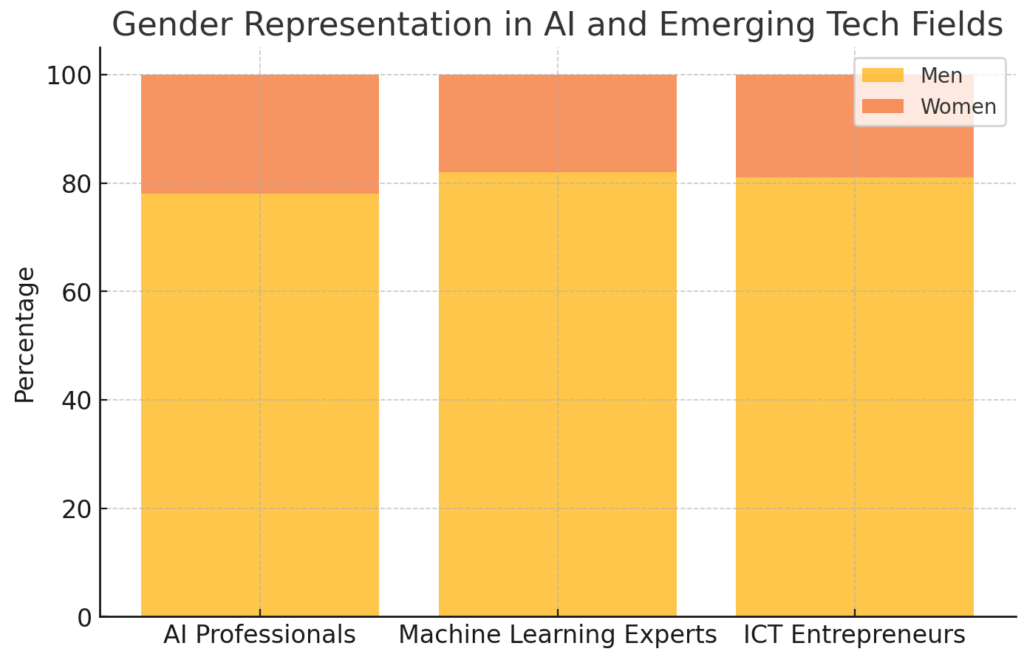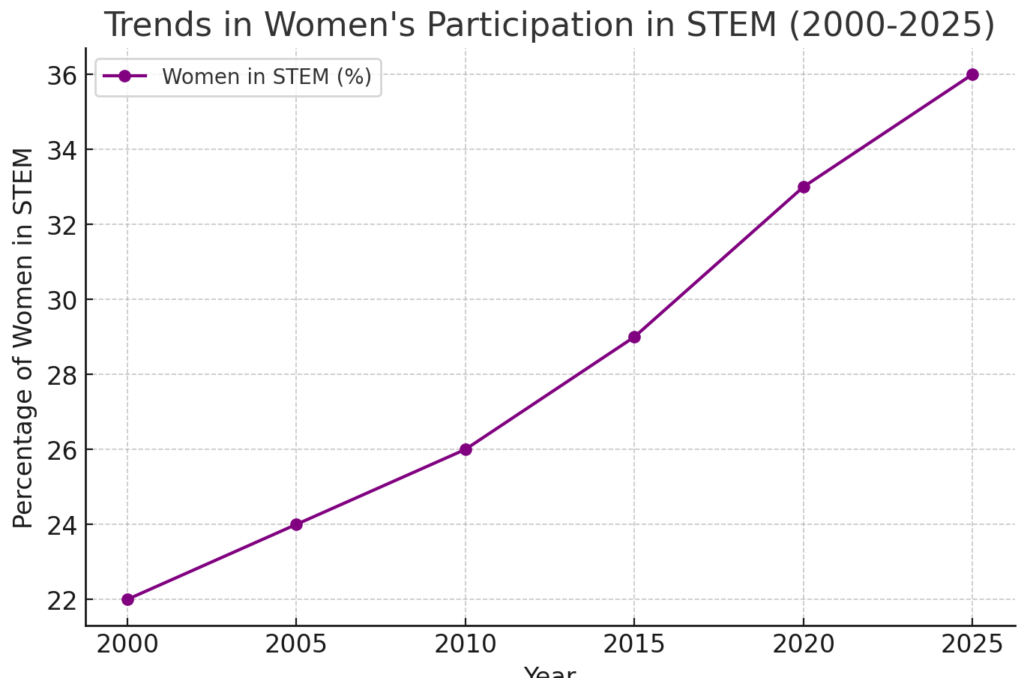Artificial Intelligence (AI) and emerging technologies are transforming industries, reshaping economies, and influencing daily life at an unprecedented pace. From self-driving cars to advanced healthcare diagnostics, AI’s impact is undeniable. Yet, despite this progress, women remain vastly underrepresented in AI and tech-related fields. If this disparity persists, the digital divide will widen, reinforcing gender inequality and allowing biases to seep into the very technology that shapes our future.
The Gender Gap in AI: The Numbers Speak
Women account for only 22% of AI professionals globally (World Economic Forum, 2023). Even more concerning, in machine learning—a critical subset of AI—female representation falls to 18% (AI Index Report, 2022). The European Commission’s Digital Decade Strategy (2022) revealed that only 19% of ICT entrepreneurs in Europe are women, despite the sector’s rapid growth and high earning potential.
“We are designing a future where AI decision-making impacts billions of lives, yet the creators of these technologies are overwhelmingly male. This leads to unintended biases that disproportionately harm women and marginalized communities,” warns Dr. Fei-Fei Li, a prominent AI researcher and co-founder of AI4ALL, a nonprofit organization promoting diversity in AI.

Data Source: World Economic Forum (2023), AI Index Report (2022), European Commission Digital Decade Strategy (2022)
Barriers Preventing Women’s Participation in AI and Tech
Several key barriers prevent women from entering and thriving in AI and emerging tech fields:
- Deep-Rooted Gender Stereotypes: The perception that STEM (Science, Technology, Engineering, and Mathematics) is a “male domain” discourages young girls from pursuing AI-related careers. According to a UNESCO report (2021), only 33% of women globally study STEM disciplines at the university level.
- Lack of Female Role Models: Women remain significantly underrepresented in AI leadership and research. “When young girls don’t see women excelling in AI, they struggle to visualize themselves in that space,” says Timnit Gebru, a former Google AI ethics researcher who has advocated against gender and racial bias in AI systems.
- Bias in AI Recruitment and Workplace Culture: AI-driven hiring tools have been found to favor male applicants over female ones due to historical data that reflects past discrimination (MIT Technology Review, 2018). Furthermore, many AI research labs and companies fail to create inclusive environments, leading to high attrition rates among female employees.
- Limited Funding for Women-Led AI Startups: Women receive less than 2% of venture capital funding globally (Harvard Business Review, 2022), making it incredibly difficult for female AI entrepreneurs to launch and scale their businesses.
The Consequences of Gender Disparity in AI
The underrepresentation of women in AI isn’t just an equality issue—it’s a technological risk. AI systems trained on biased data can amplify existing societal inequalities.
For example, a 2018 study by MIT Media Lab found that facial recognition systems had an error rate of 34.7% when identifying darker-skinned women, compared to just 0.8% for lighter-skinned men. This bias can lead to wrongful arrests, discriminatory hiring practices, and unequal access to essential services.
“The biases we see in AI today are a reflection of our historical inequalities. Without women in AI, we risk automating discrimination at an unprecedented scale,” warns Joy Buolamwini, founder of the Algorithmic Justice League, an organization dedicated to combating bias in AI.
Women Leading the Way in AI and Emerging Tech
Despite these challenges, several female pioneers are breaking barriers and shaping the future of AI:
- Dr. Fei-Fei Li: A leader in AI research, she co-founded AI4ALL to foster diversity in the field.
- Timnit Gebru: A vocal advocate for ethical AI, she has exposed racial and gender biases in facial recognition.
- Joy Buolamwini: Her work on algorithmic bias has led to policy changes in AI development.
- Kate Crawford: A researcher highlighting the social and ethical implications of AI.

Data Source: UNESCO (2021), AI Index Report (2022), McKinsey & Company (2023)
Bridging the Digital Gender Divide: Solutions & Best Practices
To ensure AI is fair, inclusive, and representative, the following strategies must be implemented:
- Early Education Initiatives: Programs like Girls Who Code, AI4ALL, and Code First Girls introduce AI and programming to young girls, fostering interest in tech careers from an early age.
- Corporate Diversity Policies: Tech giants such as Google, IBM, and Microsoft are investing in diversity-focused AI training and hiring initiatives. However, more companies must commit to transparent hiring and promotion policies to close the gender gap.
- Government and Policy Interventions: The EU’s Digital Decade Strategy (2022) aims to have 20 million ICT specialists by 2030, with a focus on achieving gender balance in tech-related roles. Policies that fund female-led AI startups and enforce equal pay in STEM are crucial.
- Mentorship and Sponsorship: Establishing structured mentorship programs connecting young women with female AI professionals can provide guidance and support.
- Bias Audits in AI Development: AI models should be routinely audited for gender bias to ensure fair and ethical technology deployment.
Conclusion: The Future of AI Must Be Inclusive
The future of AI and emerging technologies cannot be built by only half of the population. Women’s participation is not just a matter of fairness—it’s essential for technological innovation, economic growth, and societal well-being. By addressing biases in AI education, recruitment, and leadership, we can bridge the digital divide and ensure AI serves all of humanity equally.
As Dr. Fei-Fei Li puts it, “AI is neither good nor bad. It’s what we make it. And to make it better, we need all voices at the table.”
Bibliography
- World Economic Forum (2023). “Global Gender Gap Report 2023.” Retrieved from: https://www.weforum.org/reports/global-gender-gap-report-2023
- AI Index Report (2022). “Measuring Trends in Artificial Intelligence.” Retrieved from: https://aiindex.stanford.edu/report/
- UNESCO (2021). “Cracking the Code: Girls’ and Women’s Education in STEM.” Retrieved from: https://unesdoc.unesco.org/
- MIT Technology Review (2018). “How AI Hiring Tools Discriminate Against Women.” Retrieved from: https://www.technologyreview.com/
- Harvard Business Review (2022). “Why Women Entrepreneurs Receive Less Funding.” Retrieved from: https://hbr.org/
- EU Commission (2022). “The Digital Decade Strategy.” Retrieved from: https://digital-strategy.ec.europa.eu/en/policies/digital-decade
- MIT Media Lab (2018). “Gender Shades: Bias in Facial Recognition.” Retrieved from: https://www.media.mit.edu/projects/gender-shades/

 English
English Български
Български Ελληνικά
Ελληνικά Polski
Polski Română
Română